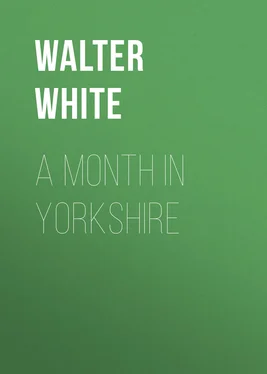Walter White - A Month in Yorkshire
Здесь есть возможность читать онлайн «Walter White - A Month in Yorkshire» — ознакомительный отрывок электронной книги совершенно бесплатно, а после прочтения отрывка купить полную версию. В некоторых случаях можно слушать аудио, скачать через торрент в формате fb2 и присутствует краткое содержание. Жанр: Путешествия и география, История, foreign_edu, foreign_antique, foreign_prose, на английском языке. Описание произведения, (предисловие) а так же отзывы посетителей доступны на портале библиотеки ЛибКат.
- Название:A Month in Yorkshire
- Автор:
- Жанр:
- Год:неизвестен
- ISBN:нет данных
- Рейтинг книги:3 / 5. Голосов: 1
-
Избранное:Добавить в избранное
- Отзывы:
-
Ваша оценка:
- 60
- 1
- 2
- 3
- 4
- 5
A Month in Yorkshire: краткое содержание, описание и аннотация
Предлагаем к чтению аннотацию, описание, краткое содержание или предисловие (зависит от того, что написал сам автор книги «A Month in Yorkshire»). Если вы не нашли необходимую информацию о книге — напишите в комментариях, мы постараемся отыскать её.
A Month in Yorkshire — читать онлайн ознакомительный отрывок
Ниже представлен текст книги, разбитый по страницам. Система сохранения места последней прочитанной страницы, позволяет с удобством читать онлайн бесплатно книгу «A Month in Yorkshire», без необходимости каждый раз заново искать на чём Вы остановились. Поставьте закладку, и сможете в любой момент перейти на страницу, на которой закончили чтение.
Интервал:
Закладка:
“Climb at court for me that will—
Tottering favour’s pinnacle;
All I seek is to lie still,
Settled in some secret nest,
In calm leisure let me rest,
And far off the public stage,
Pass away my silent age.
Thus, when without noise, unknown,
I have lived out all my span,
I shall die without a groan,
An old honest countryman.”
Then Patrington—erst Patrick’s town—one of those simple-looking places which contrast agreeably with towns sophisticated by the clamour and bustle of trade; and although a few gas-lamps tell of innovation, a market not more than once a fortnight upholds the authority of ancient usage. You see nearly the whole of the town at once; a long, wide, quiet street, terminated by a graceful spire, so graceful, indeed, that it will allure you at once to the church from which it springs; and what a feast for the eye awaits you! Truly the “pride of Holderness” is not monopolised by Hedon. The style is that which prevailed in the reign of Edward II., and is harmonious throughout, from weathercock to door-sill. You will walk round it again and again, admiring the beauty of its design and proportion, pausing oft to contemplate the curious carvings, and the octagonal spire springing lightly from flying buttresses to a height of one hundred and ninety feet. The gargoyles exhibit strange conceits; chiselled to represent a fiddler—a bagpiper—a man holding a pig—a fiend griping a terrified sinner—a lion thrusting his tongue out—and others equally incongruous. How I wished the architect would come to life for an hour to tell me what he meant by them, and by certain full-length figures carved on the buttresses, which accord so little with our modern sense of decency, much less with the character of a religious house! Inside you find a corresponding lightness and gracefulness, and similarly relieved by a sprinkling of monsters. The east or ‘Ladye aisle’ contains three chantry chapels; the ‘Easter sepulchre’ is a rare specimen of the sculptor’s art, and the font hewn from a single block of granite displays touches of a master hand. St. Patrick’s church at Patrington is an edifice to linger in; an example of beauty in architecture in itself worth a journey to Yorkshire.
There are relics, too, of an earlier age: embankments discovered some feet below the present surface, fragments of buildings, an altar, and other objects of especial interest to the antiquary, for they mark Patrington as the site of a Roman station. An important station, if the supposition be correct that this was the Prætorium of Antoninus—the place where some of the legions disembarked to subjugate the Brigantes.
To eat breakfast under the sign of the Hildyard Arms —a name, by the way, which preserves in a modified form the old Saxon Hildegarde —seemed like connecting one’s-self with remote antiquity. The ancestors of the Hildyards were here before the Conquest. One of the family, Sir Christopher, is commemorated by a handsome monument in Winestead church. The landlord, willing to entertain in more ways than one, talked of the improvements that had taken place within his remembrance. The railway was not one of them, for it took away trade from the town, and deadened the market. Visitors were but few, and most of those who came wondered at seeing so beautiful a church in such an out-of-the-way place. He could show me a garden near the churchyard which was said to be the spot where the building-stone was landed from boats; but the water had sunk away hundreds of years ago. Patrington haven—a creek running up from the Humber—had retreated from the town, and since the reclamation of Sunk Island, required frequent dredging to clear it of mud. The farmers in the neighbourhood were very well content with the harvests now yielded by the land. In 1854 some of them reaped “most wonderful crops.”
I had seen a woman painting her door-posts, and asked him whether that was recognised as women’s work in Patrington. “Sure,” he answered, “all over the country too. Women do the whitewashing, and painting, ay, and the paper-hanging. Look at this room, now! My daughter put that up.”
I did look, and saw that the pattern on the walls sloped two or three inches from the perpendicular, whereby opposite sides of the room appeared to be leaning in contrary directions. However, I said nothing to disparage the damsel’s merits.
From Patrington to Spurn the distance is thirteen miles. Hoping to walk thither and back in the day, I snapped the thread of the landlord’s talk, and set out for the lighthouse. Presently I overtook a man, and we had not walked half a mile together before I knew that he was a master-painter in a small way at Patrington, now going to paper a room at Skeffling, a village five miles off. To hear that he would get only sixpence a piece for the hanging surprised me, for I thought that nowhere out of London would any one be silly enough to hang paper for a halfpenny a yard.
“You see,” he rejoined, “there’s three in the trade at Patrington, and then ’tis only the bettermost rooms that we gets to do. The women does all the rest, and the painting besides. That’s where it is. But ’taint such a very bad job as I be going to. They finds their own paste, and there’s nine pieces to hang: that’ll give me four and sixpence; and then I shall get my dinner, and my tea too, if I don’t finish too soon. So it’ll be a pretty fair day’s work.” And yet the chances were that he would have to wait six months for payment.
We passed through Welwick—place of wells—a small, clean village, with a small, squat church, with carvings sadly mutilated on the outside, and inside, a handsome tomb. At Plowland, near this, lived the Wrights, confederates in the Gunpowder Plot. Nearly all the cottages are models of cleanliness; the door-sill and step washed with yellow ochre, and here and there you see through the open door that the walls of the room inside are papered, and the little pictures and simple ornaments all in keeping. You will take pleasure in these indications, and perhaps believe them to be the result of an affection for cleanliness. The walls of some of the houses and farm-yards are built of pebbles—‘sea-cobbles,’ as they are called—placed zigzag-wise, with a novel and pretty effect: and the examples multiply as we get nearer the sea, where they may be seen in the walls of the churches.
At Skeffling the painter turned into a farm-house which looked comfortably hospitable enough to put him at ease regarding his dinner, and as if it had little need to take six months’ credit for four and sixpence, while I turned from the high-road into a track leading past the church—which, by the way, has architectural features worthy examination—to the coarse and swarthy flats where the distant view is hidden by a great embankment that runs along their margin for miles. Once on the top of this ‘Humber-bank,’ I met a lusty breeze sweeping in from the sea, and had before me a singular prospect—the bank itself stretching far as the eye can see in a straight line to the east and west, covered with coarse grass and patches of gray, thistle-like, sea-holly— Eryngo maritima . Its outer sloop is loose sand falling away to the damp line left by the tide, beyond which all is mud—a great brown expanse outspread for miles. The tide being at its lowest, only the tops of the masts of small vessels are to be seen, moving, as it seems, mysteriously: the river itself is hardly discernible. In places the mud lies smooth and slimy; in others thickly rippled, or tossed into billows, as if the water had stamped thereon an impression of all its moods. Fishermen wade across it in huge boots from their boats to the firm beach, and dig down through it two or three feet to find stiff holding-ground for their anchors.
Читать дальшеИнтервал:
Закладка:
Похожие книги на «A Month in Yorkshire»
Представляем Вашему вниманию похожие книги на «A Month in Yorkshire» списком для выбора. Мы отобрали схожую по названию и смыслу литературу в надежде предоставить читателям больше вариантов отыскать новые, интересные, ещё непрочитанные произведения.
Обсуждение, отзывы о книге «A Month in Yorkshire» и просто собственные мнения читателей. Оставьте ваши комментарии, напишите, что Вы думаете о произведении, его смысле или главных героях. Укажите что конкретно понравилось, а что нет, и почему Вы так считаете.












